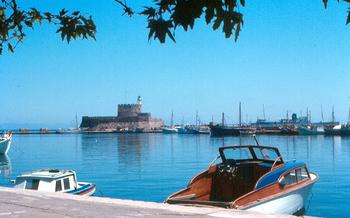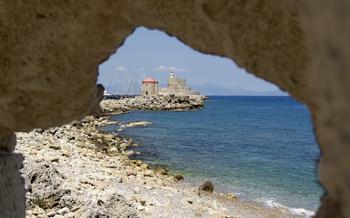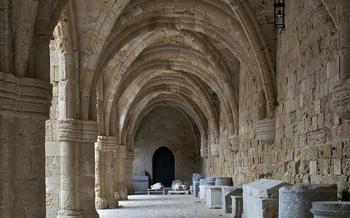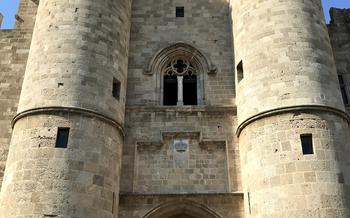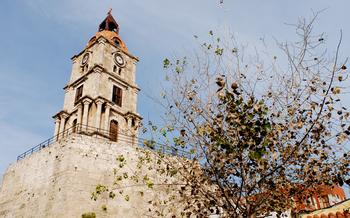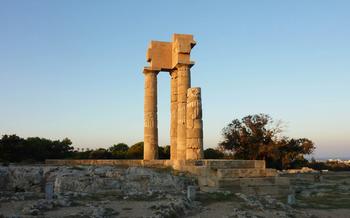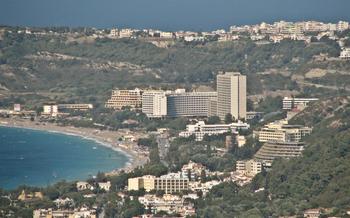
Acropolis of Rhodes
- A Journey Through History: Unveiling the Acropolis of Rhodes
- Conquering the Heights: A Scenic Ascent to the Acropolis
- In the Footsteps of Ancient Civilizations: Exploring the Archaeological Sites
- The Acropolis Museum: A Treasure Trove of Ancient Wonders
- The Temple of Apollo: A Divine Abode
- The Odeon: A Stage for Ancient Performances
- Fortifications and Gates: Guardians of the Acropolis
- The Street of the Knights: A Walk Through History
- The Palace of the Grand Master: A Seat of Power
- The Archaeological Museum of Rhodes: A Journey Through Time
- Monte Smith: A Verdant Oasis Atop the Acropolis
- The Clock Tower: A Symbol of Time and Change
- The Turkish Baths: A Legacy of Relaxation and Well-being
- The Jewish Quarter: A Mosaic of History and Heritage
- Insider Tip: Unveiling the Hidden Gems of the Acropolis
A Journey Through History: Unveiling the Acropolis of Rhodes
The Acropolis of Rhodes, a historical marvel that once commanded the skyline of the ancient city, stands as a testament to the island's rich past and enduring legacy. Perched atop Monte Smith, the acropolis offers breathtaking panoramic views, archaeological treasures, and captivating tales of ancient civilizations.
Its strategic location, overlooking the meeting point of the Aegean and Mediterranean Seas, made it a coveted stronghold and a vital trading hub. The acropolis served as the religious, administrative, and defensive center of ancient Rhodes, playing a pivotal role in shaping its history and destiny.
Among the most notable landmarks of the acropolis is the Temple of Apollo, a magnificent structure dedicated to the sun god, Helios. Its imposing columns and intricate pediments stand as a testament to the architectural prowess of the ancient Rhodians. The odeon, a smaller yet equally impressive structure, hosted cultural performances, public gatherings, and political debates, echoing with the voices of ancient philosophers, poets, and musicians.
Through the centuries, the acropolis has witnessed the rise and fall of civilizations, from the ancient Greeks to the Romans, Byzantines, and Ottomans. Each era left its mark on this sacred site, adding layers of history and intrigue to its already captivating narrative.
Prepare to be transported back in time as we embark on a journey through the Acropolis of Rhodes, uncovering the secrets of this ancient citadel and immersing ourselves in the grandeur of its storied past.
Conquering the Heights: A Scenic Ascent to the Acropolis
Reaching the Acropolis of Rhodes is a journey in itself, offering breathtaking views and a glimpse into the city's rich past.
There are several routes leading to the Acropolis, each presenting its own unique charm. Whether you choose to stroll along the scenic paths or embark on a challenging hike, the ascent is rewarded with panoramic vistas that stretch far beyond the ancient walls.
As you make your way up, keep an eye out for the fortifications and gates that stand as silent witnesses to the Acropolis's defensive past. These architectural marvels, once instrumental in protecting the city from invaders, now serve as reminders of Rhodes' resilience and strategic importance.
To fully appreciate the Acropolis's grandeur, time your visit carefully. The early morning light casts a warm glow on the ancient stones, while the sunset paints the sky in hues of gold and purple, creating a magical ambiance. Whether you prefer the tranquility of dawn or the drama of dusk, the Acropolis offers a visual feast at any hour.
In the Footsteps of Ancient Civilizations: Exploring the Archaeological Sites
The Acropolis of Rhodes is a treasure trove of archaeological wonders, offering a glimpse into the city's rich and diverse past. As you wander through the site, you'll encounter the ruins of ancient city walls, once formidable barriers that protected Rhodes from invaders. These walls, with their imposing gateways and towers, stand as testaments to the city's strategic importance and its ability to withstand sieges.
Amidst the ruins, you'll discover the remains of temples, altars, and public buildings, each showcasing the architectural ingenuity of the ancient Rhodians. These structures, with their intricate carvings and decorative elements, provide a glimpse into the religious beliefs, civic life, and cultural practices of this ancient civilization.
As you explore further, keep an eye out for fragments of ancient pottery and artifacts scattered throughout the site. These remnants of everyday life offer valuable insights into the domestic and economic activities of the Rhodians. From ceramic vessels and tools to coins and jewelry, these artifacts provide a tangible connection to the people who once inhabited this vibrant city.
The archaeological findings at the Acropolis of Rhodes are not merely relics of the past; they are essential pieces of a puzzle that help us understand the evolution of this ancient city. Through these discoveries, we gain a deeper appreciation for the rich history and cultural heritage of Rhodes, a place where the echoes of ancient civilizations still resonate today.
The Acropolis Museum: A Treasure Trove of Ancient Wonders
The Acropolis Museum, situated at the foot of the ancient citadel, stands as a testament to Rhodes' rich cultural legacy. Within its walls lies an impressive collection of artifacts unearthed from the Acropolis and its surroundings, offering visitors a glimpse into the island's glorious past.
As you step into the museum, you are greeted by a stunning array of sculptures, pottery, and mosaics, each narrating a chapter in Rhodes' history. Among the highlights is the renowned Colossus of Rhodes, a colossal statue that once stood as one of the Seven Wonders of the Ancient World. Although only fragments of the statue remain, its grandeur and significance continue to captivate visitors.
The museum's interactive displays and multimedia presentations bring the ancient world to life, providing insights into the daily lives, religious practices, and artistic traditions of the Rhodians. These immersive experiences enhance the visitor's understanding of the island's rich cultural heritage.
The Acropolis Museum plays a crucial role in preserving and showcasing Rhodes' cultural treasures. Through its extensive collection and innovative exhibits, the museum not only safeguards the island's past but also ensures that its legacy continues to inspire and educate generations to come.
The Temple of Apollo: A Divine Abode
Architectural Marvel: The Temple of Apollo, a prominent landmark within the Acropolis of Rhodes, stands as a testament to ancient Greek architectural prowess. Its imposing columns, intricately carved pediment, and well-preserved remains evoke a sense of awe and wonder. The temple's grand entrance, adorned with decorative elements, invites visitors to step back in time and experience the grandeur of ancient religious practices.
Center of Worship: Serving as the religious epicenter of ancient Rhodes, the Temple of Apollo held immense significance for the Rhodians. They revered Apollo, the god of light, music, and prophecy, considering him their patron deity. Within the temple's sacred chambers, priests performed rituals, offered prayers, and sought divine guidance. The temple's location atop the Acropolis further emphasized its importance, as it was believed to be closer to the heavens and the gods.
Mythological Tales: The Temple of Apollo is closely intertwined with various mythological tales and legends that add to its mystique. According to one myth, Apollo himself chose the site of the temple after being captivated by the island's beauty during his travels. Another legend tells of the Telchines, mythical craftsmen who were said to have built the temple using their extraordinary skills. These stories have been passed down through generations, enriching the temple's history and capturing the imagination of visitors.
Current State: While time and natural elements have taken their toll on the Temple of Apollo, its ruins still stand as a testament to its former glory. The temple's foundations, columns, and pediment remain intact, allowing visitors to appreciate its architectural grandeur. The temple's enduring presence serves as a reminder of the deep religious beliefs and practices that shaped ancient Rhodian society.
The Odeon: A Stage for Ancient Performances
Description of the Odeon's Structure, Seating Arrangements, and Acoustics
The Odeon of Rhodes is an ancient theater located on the slopes of the Acropolis. It was built in the 2nd century BC and could accommodate up to 800 spectators. The theater has a semi-circular shape and is divided into two tiers of seating. The lower tier is made up of 14 rows of marble seats, while the upper tier has 13 rows of stone seats. The stage is located at the center of the theater and is surrounded by a raised platform. The Odeon has excellent acoustics, which makes it a popular venue for concerts and performances even today.
Purpose of the Odeon as a Venue for Musical Performances, Theatrical Productions, and Public Speeches
The Odeon was used for a variety of purposes in ancient times. It was primarily used for musical performances, such as concerts and recitals. It was also used for theatrical productions, such as plays and comedies. In addition, the Odeon was used for public speeches and lectures.
Events and Festivals that Took Place in the Odeon, Highlighting its Cultural Significance
The Odeon was a major cultural center in ancient Rhodes. It hosted a variety of events and festivals throughout the year. Some of the most popular events included the Dionysia, a festival in honor of the god Dionysus, and the Pythian Games, a musical and athletic competition.
Current Use of the Odeon for Cultural Events and Performances, Preserving its Legacy
The Odeon is still used for cultural events and performances today. It is a popular venue for concerts, plays, and other performances. The Odeon is also used for educational purposes, such as lectures and workshops.
Fortifications and Gates: Guardians of the Acropolis
The Acropolis of Rhodes was a formidable fortress, protected by an intricate system of fortifications. These fortifications were designed to withstand attacks from both land and sea and played a crucial role in safeguarding the city from invasion.
The fortifications consisted of massive walls, towers, and gates. The walls were constructed from huge blocks of stone and were up to 12 meters thick in some places. The towers were strategically placed along the walls and provided a commanding view of the surrounding area. The gates were heavily fortified and were the only means of access to the Acropolis.
Some of the most notable gates of the Acropolis include the Gate of Apollo, the Gate of Athena, and the Gate of St. John. The Gate of Apollo was the main entrance to the Acropolis and was decorated with sculptures of the god Apollo. The Gate of Athena was located on the east side of the Acropolis and was named after the goddess Athena, who was the patron deity of Rhodes. The Gate of St. John was built by the Knights of St. John and was located on the west side of the Acropolis.
These fortifications were not only essential for defense but also shaped the urban landscape of ancient Rhodes. The walls and towers formed a distinct silhouette against the skyline, and the gates served as focal points for the city's streets and squares. Today, the fortifications of the Acropolis stand as a testament to the ingenuity and resilience of the ancient Rhodians.
The Street of the Knights: A Walk Through History
In the heart of the Acropolis, a historical promenade awaits travelers – the Street of the Knights. This enchanting cobbled street lined with imposing medieval buildings once served as the home to the Knights of St. John, a powerful order of crusaders who ruled Rhodes for over 200 years.
Step back in time as you wander along this grand avenue, where each building holds a tale of chivalry and intrigue. Admire the Gothic and Renaissance architectural influences reflected in their ornate facades, intricate carvings, and arched doorways.
During their reign, the Knights transformed Rhodes into a thriving center of commerce and culture. Imagine the hustle and bustle of knights, merchants, and pilgrims traversing this very street, their footsteps echoing amidst the towering walls.
Today, the Street of the Knights continues to captivate visitors with its timeless charm. Stroll through its length, stopping to browse the boutiques and souvenir shops housed within these historic buildings. Savor a traditional Greek meal in one of the many restaurants lining the street, savoring the flavors of the island while immersed in its rich history.
As the sun dips below the horizon, the street takes on a magical aura, illuminated by flickering lanterns that cast warm glows upon the ancient stones. Take a moment to soak in the atmosphere and allow your imagination to transport you back to the days of chivalry and crusades.
The Palace of the Grand Master: A Seat of Power
The Palace of the Grand Master stands as a testament to the power and influence of the Knights of St. John during their reign over Rhodes. Built in the 14th century, this magnificent structure served as the residence of the Grand Master, the leader of the order. With its imposing presence and intricate architectural details, the palace reflects the wealth and prestige of the Knights.
The palace boasts a grand entrance, leading to a series of courtyards, halls, and chambers. Visitors can admire the exquisite craftsmanship of the Gothic and Renaissance architecture, with its vaulted ceilings, ornate doorways, and decorative elements. The palace's courtyards, with their lush gardens and fountains, provide a tranquil oasis amidst the bustling city.
One of the highlights of the palace is its grand staircase, which leads to the upper floors. The staircase is adorned with intricate carvings and sculptures, showcasing the artistic prowess of the era. The palace also features a series of halls, each with its own unique character and purpose. The Hall of the Knights, with its impressive vaulted ceiling, was used for meetings and ceremonies.
Today, the Palace of the Grand Master serves as a museum, showcasing the rich history and heritage of the Knights of St. John. Visitors can explore the palace's many rooms and chambers, which house a collection of artifacts, paintings, and sculptures. The museum provides a glimpse into the lives and achievements of the Knights, shedding light on their role in shaping the history of Rhodes.
The Archaeological Museum of Rhodes: A Journey Through Time
The Archaeological Museum of Rhodes is a treasure trove of artifacts that tell the story of Rhodes' rich history, from prehistoric times to the Hellenistic period. Located in the heart of the city, just a short walk from the Acropolis, the museum houses a vast collection of sculptures, pottery, jewelry, and other artifacts that provide a glimpse into the island's past.
One of the highlights of the museum is the Aphrodite of Rhodes, a beautiful marble statue of the goddess of love and beauty. Discovered on the island in the 19th century, the statue is a masterpiece of ancient Greek sculpture and is considered one of the most important works of art in the museum's collection.
The museum also houses a number of significant prehistoric artifacts, including pottery, tools, and weapons. These objects offer a glimpse into the lives of the early inhabitants of Rhodes, who lived on the island as early as the Neolithic period.
In addition to its prehistoric and classical collections, the museum also has a number of exhibits that focus on the Hellenistic period, when Rhodes was a major center of learning and culture. Among the highlights of this collection are a number of bronze statues, including the famous Colossus of Rhodes, one of the Seven Wonders of the Ancient World.
The Archaeological Museum of Rhodes is a must-see for anyone interested in the history of Rhodes. The museum's collection is extensive and well-curated, and the exhibits are informative and engaging. Whether you're a history buff or simply looking to learn more about Rhodes, the Archaeological Museum is a great place to start.
Monte Smith: A Verdant Oasis Atop the Acropolis
Monte Smith, a verdant hill crowned with the remnants of ancient fortifications, stands as a testament to Rhodes' rich and layered history. Once the site of the ancient acropolis, it later served as the foundation for a medieval fortress, leaving behind a captivating blend of architectural styles. Ascending its slopes, visitors are greeted by a tranquil oasis, where lush gardens burst with vibrant colors and fragrant blossoms.
Monte Smith offers a sanctuary of serenity amidst the bustling city, inviting visitors to pause and savor the breathtaking panoramas that unfold before them. From its elevated vantage point, the entire city of Rhodes stretches out like a living tapestry, with the sparkling Aegean Sea shimmering in the distance. The terracotta roofs of the Old Town, the imposing walls of the Palace of the Grand Master, and the slender minarets of mosques paint a picturesque scene that captures the essence of Rhodes' diverse heritage.
Strolling through the verdant paths of Monte Smith, visitors can immerse themselves in the tranquility of nature, far removed from the vibrant energy of the city below. The gardens, meticulously landscaped with native flora, provide a haven for local wildlife, creating a harmonious coexistence between history and the natural world.
Atop Monte Smith, time seems to slow down, allowing visitors to soak in the beauty of the surroundings and contemplate the passage of time. Whether seeking a moment of respite, capturing stunning photographs, or simply enjoying a leisurely picnic, Monte Smith offers an idyllic setting for creating lasting memories in Rhodes.
The Clock Tower: A Symbol of Time and Change
Amidst the ancient ruins and medieval structures of the Acropolis, the Clock Tower stands tall, a testament to the passage of time and the changing fortunes of Rhodes. Built during the Ottoman era, this iconic landmark has become a beloved symbol of the city, beckoning visitors with its intricate architecture and panoramic views.
As you approach the Clock Tower, its imposing presence commands attention. The tower's sturdy stone walls and graceful arches reflect the architectural prowess of the Ottoman Empire, blending seamlessly with the surrounding historical treasures. Adorned with intricate carvings and decorative elements, the tower exudes an air of grandeur and timeless elegance.
Climb the winding staircase to the top of the Clock Tower, and you'll be rewarded with breathtaking panoramic views of Rhodes. The city unfolds before you, a tapestry of terracotta roofs, whitewashed buildings, and shimmering turquoise waters. From this vantage point, you can trace the city's rich history, from its ancient origins to its modern-day cosmopolitan vibe.
The clock itself is a masterpiece of craftsmanship, its intricate mechanism still faithfully marking the hours with a melodic chime. As the sun sets, casting a golden glow over the Acropolis, the Clock Tower stands illuminated, a beacon of time guiding you through the centuries.
Whether you're a history buff, an architecture enthusiast, or simply a traveler seeking a unique experience, the Clock Tower is a must-visit destination within the Acropolis of Rhodes. Let its grandeur transport you back in time, as you marvel at the enduring legacy of this iconic landmark.
The Turkish Baths: A Legacy of Relaxation and Well-being
Amidst the historical tapestry of the Acropolis of Rhodes, the Turkish Baths stand as a testament to the city's diverse cultural heritage. Built during the Ottoman period, these baths were once a place of relaxation and rejuvenation for the city's inhabitants.
Step inside the domed chambers of the Turkish Baths, and you'll be transported back in time. Intricate tilework adorns the walls, while pools of water invite you to indulge in a soothing soak. The baths were designed to provide a holistic experience, with steam rooms, massage rooms, and cooling pools catering to the needs of weary travelers and locals alike.
Today, the Turkish Baths have been transformed into a cultural center, hosting exhibitions and events that celebrate the rich history and traditions of Rhodes. Visitors can wander through the restored chambers, admiring the architectural details and imagining the bustling atmosphere of the baths in their heyday.
As you explore the Turkish Baths, take a moment to reflect on the diverse influences that have shaped Rhodes' cultural landscape. The baths are a reminder of the city's Ottoman past, a time when Rhodes was a crossroads of cultures and a center of trade.
Whether you're a history buff, an architecture enthusiast, or simply seeking a unique cultural experience, the Turkish Baths are a must-visit destination within the Acropolis of Rhodes. Immerse yourself in the tranquil ambiance of these ancient chambers and discover a hidden gem that offers a glimpse into Rhodes' fascinating past.
The Jewish Quarter: A Mosaic of History and Heritage
Nestled within the heart of the Acropolis, the Jewish Quarter stands as a testament to the rich cultural tapestry of Rhodes. Its cobblestone streets and timeworn buildings whisper tales of a vibrant community that once thrived within these ancient walls.
The presence of synagogues, Jewish schools, and other landmarks speaks to the deep roots of the Jewish community in Rhodes. These structures, with their intricate architectural details and poignant historical significance, offer a glimpse into a heritage that has endured for centuries.
The buildings of the Jewish Quarter showcase a harmonious blend of Jewish and local influences, reflecting the unique fusion of cultures that has shaped Rhodes' identity. From the distinctive arched doorways to the colorful tilework, each building tells a story of coexistence and cultural exchange.
Today, the Jewish Quarter stands as a vibrant testament to the resilience and legacy of Rhodes' Jewish community. While the community may have dispersed over time, their cultural heritage continues to live on, preserved within the walls of this historic district.
As you wander through the narrow alleys and explore the hidden corners of the Jewish Quarter, let the spirit of history guide you. Discover the hidden gems that lie waiting for the curious traveler, and immerse yourself in the rich tapestry of cultures that have made Rhodes the vibrant and diverse destination it is today.
Insider Tip: Unveiling the Hidden Gems of the Acropolis
Beyond the main attractions, the Acropolis of Rhodes holds a treasure trove of hidden gems waiting to be discovered by curious travelers. Venture off the beaten path to uncover secluded viewpoints that offer breathtaking panoramas of the city, coast, and surrounding landscapes. Immerse yourself in the local culture by seeking out charming cafes tucked away in quiet corners, where you can savor traditional Greek flavors and engage in conversations with friendly locals.
Keep an eye out for remnants of the past, such as ancient ruins and historical artifacts, which can be found scattered throughout the Acropolis area. These hidden treasures provide a glimpse into the rich history and diverse heritage of Rhodes, adding depth and intrigue to your exploration.
To fully appreciate the magic of the Acropolis, consider visiting at different times of the day. As the sun rises, the ancient stones glow with a warm golden hue, creating a serene and contemplative atmosphere. As the day progresses, the Acropolis transforms under the bright sunlight, revealing intricate details of its architecture and offering stunning views of the surrounding landscape. As dusk settles, the Acropolis takes on a mystical aura, with the soft light casting long shadows and creating a perfect backdrop for capturing captivating photographs.
Combine your visit to the Acropolis with other nearby attractions to create a comprehensive Rhodes experience. Explore the bustling streets of the Old Town, with its vibrant markets, traditional tavernas, and historical landmarks. Visit the nearby beaches to bask in the warm Mediterranean sun and indulge in water sports or simply relax on the sandy shores. Take a boat trip to neighboring islands, such as Symi or Chalki, to discover their unique charm and natural beauty.
Whether you're a history buff, a culture enthusiast, or simply a traveler seeking unique experiences, the Acropolis of Rhodes offers a wealth of hidden gems that will leave you captivated and eager to return. Embrace the spirit of exploration, let your curiosity guide you, and uncover the secrets that lie within this ancient citadel.
